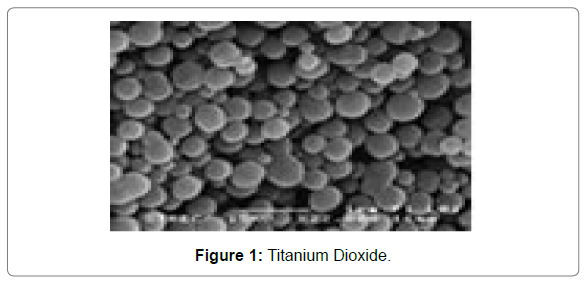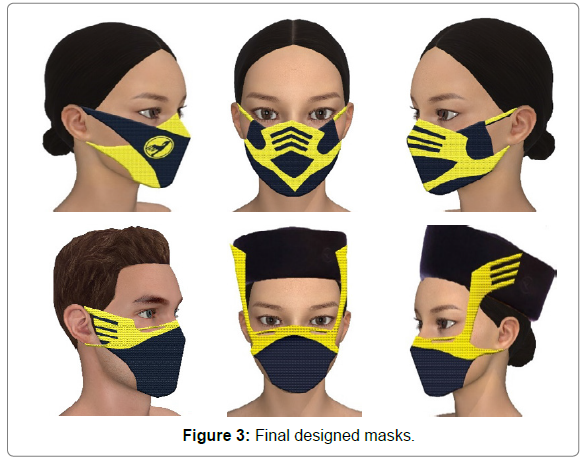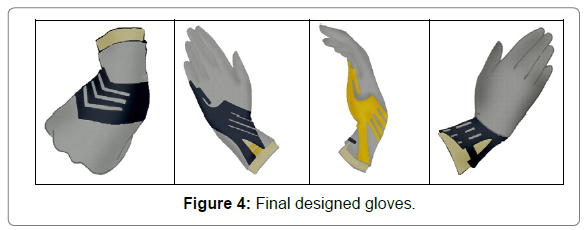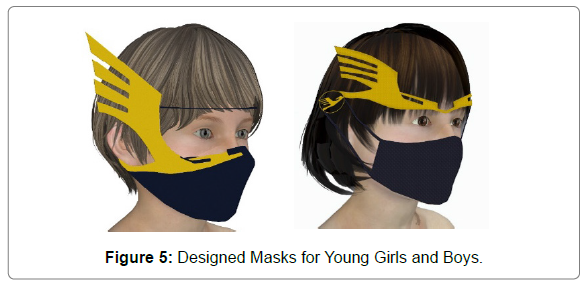Short Communication, J Fashion Technol Textile Eng Vol: 0 Issue: 0
Design of Protective Fabric Masks and Gloves Based on Lufthansa Airline Logo
Akram Shahbeigihassanabadi, Salar Zohoori*, Abolfazl Davodiroknabadi and Mehrnoosh Sakenyandehkordi
Department of Design and Clothing, Imam Javad University College, Yazd, Iran
- *Corresponding Author:
- Salar Zohoori
Department of Design and Clothing, Imam Javad University College, Yazd, Iran
E-mail: s_textile@yahoo.com
Received Date: July 09, 2021; Accepted Date: July 27, 2021; Published Date: August 03, 2021
Citation: Shahbeigihassanabadi A, Zohoori S, Davodiroknabadi A, Sakenyandehkordi M (2021) Design of Protective Fabric Masks and Gloves Based on Lufthansa Airline Logo. J Fashion Technol Textile Eng 9:7. 216.
Copyright: © All articles published in Journal of Fashion Technology & Textile Engineering are the property of SciTechnol, and is protected by copyright laws. Copyright © 2021, SciTechnol, All Rights Reserved.
Abstract
The present study investigated the effects and protective role of masks and gloves as part of the design of job uniforms to prevent the occurrence and spread of Covid-19 virus using the antibacterial properties of raw cotton samples made of Nanomaterials. Since there was no research on the specific fashion of job clothing design and mode for masks and gloves, this research is innovative in this domain. In conducting this research, both quantitative and qualitative methods used for data collection. The experiments and the method of their analysis were quantitative and special designs were completed for the mask and gloves, which were presented in a qualitative method. In this thesis, the antimicrobial productivity of cotton samples in reducing a common species of Gram-positive Staphylococcus aureus, the source of eye, skin, bone, and joint infections, was investigated. The results of antibacterial activity of raw cotton samples supplemented with Nanomaterials indicated that the raw fabrics have no microbial properties and in the treated samples the percentage of bacterial reduction for gram-positive bacteria Staphylococcus aureus was calculated to be 97.1%. Finally, the research findings showed that the design and production of protective fabric face masks and gloves suitable for jobs with this method can bring about a drastic change in the clothing industry.
Keywords: Uniform Design; Glove; Mask; Fashion; Lufthansa
Introduction
Textile and clothing design is a branch of applied arts and is based on artistic taste, creativity and scientific experiences. Beauty is the first feature that is used in this art and refers to the effort that originates from the human mind of the artist based on phenomena and sensible affairs and is manifested in the form of abstract art. Costume design is an applied art discipline that has always been influenced by artistic flows throughout its history and is not considered separate from them, and its division is based on the amount of importance a person gives to clothing and its artistic aspects. Much research has been done on the design of fabrics and clothing, and a small part of that is associated with the design of masks and gloves for jobs. since gloves and masks are considered applicable and essential accessories in the domain of health, it is better to include the beauty of the fashion world in it, and in addition to their comfort and beauty, it is necessary to protect us against viruses and infectious diseases. To this end, the design of masks and gloves protected with nano-materials and their relationship with job clothing investigated.
The Review of Literature
Mask: If we want to have a comprehensive definition of the mask, we can refer to its definition in “Farhang Farsi Emrouz (Persian to Persian Dictionary)”, which describes the mask as a “shield, mask, face mask, and a device that covers the mouth and nose to help breathing and/or preventing respiratory tract from infection [1].
John L. Spooner [2] believed that it was difficult to determine exactly when face masks were first used to help control surgical sepsis. In 1897 Johann von Mikulicz Radecki’ described a surgical mask composed of one layer of gauze. That same year Fluegge’ demonstrated that ordinary conversation could disseminate bacteria-laden droplets from the nose and mouth, substantiating the need for an effective face mask.
In an interview with the New York Times, Christos Lynteris, a medical anthropologist at the University of St Andrews in Scotland, described the face mask as a sign of something that “communicates while concealing.” A sign that can be a symbol of unity in protests, an integral part of the fashion and clothing industry in some parts of the world, and a symbol of coping and prevention of disease in times of epidemic [2].
Surgical mask, also known as medical mask or simple face mask, which is often used by treatment staff, is designed and used to prevent bacteria from escaping and dropping or airborne particulates from their mouth and nose. These masks are not designed to protect the wearer from inhaling airborne bacteria or virus particles, and in proportion to masks such as N95 or FFP made of solid materials and layers which have better protecting layers, they have less protection.
Surgical masks are designed depending on the situation of their use. Masks are usually made in three layers. This ternary material is made of a molten material within non-woven fabric. The molten material acts as a filter that prevents germs from entering and leaving the mask. Most surgical masks are wrinkled. Three piles are used so that the user can extend the mask to cover the area from the nose to the chin.
Since the 1960s, the gradual replacement of medical disposable masks with reusable masks has been renovated by consumer culture. What Life magazine enthusiastically called “discarded life” in 1955.
The first recorded use of a cloth face mask was made by a French surgeon named Paul Burger during an operation in 1897 in Paris. In the early twentieth century, masks were used to protect against infectious diseases. At the time of the outbreak of plague, Wu Lin Tee designed a mask that protected users from bacteria in experimental experiments. This mask was inspired by the 1918 flu masks. In the 1940s, face masks made of cheesecloth were used to protect nurses from tuberculosis. Cloth masks were made from non-woven fabric in the 1960s, known as surgical masks, and were used during the SARS outbreak in West Africa during the Ebola epidemic in Asia. In addition, a linen mask is a mask made of common textiles, usually cotton, which is worn over the mouth and nose. When more effective masks are not available and when physical distance is impossible, cloth face masks are recommended by public health organizations for “source control” disease in epidemic conditions to protect others from virus drops in the breath, cough and sneeze of infected mask wearers. Since they are less effective than surgical masks, they are not considered personal protective equipment by public health organizations. They are used by the general public at home and in the community as protection against both infectious diseases and airborne particulate pollution. The fabrics used to make the mask are made of different materials and determine their degree of permeability to the spread of viruses.
The first prototype of the N95 mask was inspired by a woman named “Sarah Little Trenball” whose model of medical mask was designed from her previous design of a cup bra. The N95 mask was finalized in 1972 [3].
The N95 mask is not perfect and most of them are not designed to provide complete air insulation on the face of children or people with facial hair. If air insulation is not provided, the function of the mask will not be as it is said. In addition, there are types of N95 masks that are worn in high-risk areas and do not have an exhaust air outlet valve, consequently wearing them warms the space inside the mask [4].
Dr. Anne Macintosh in her article “the history of face masks” expressed that, generally speaking, face masks have several terms: medical mask, surgical mask, operation mask. The purpose of the mask is to prevent any bacteria or viruses’ particles from healthcare providers getting to the patients. That is, masks were designed to protect the patients, not the healthcare providers. Today, there are different levels of mask protection, depending on the specific needs. Mask use has also expanded outside of the medical and dental arena… the general population uses masks, too. Basically, medical masks were being developed before antibiotics had widespread use; the goal was to prevent pathogens from healthcare providers getting to their patients. That is, masks were designed to protect the patients, not the healthcare providers [5].
The earliest recorded face mask-like objects in history date to the 6th century BC. Some images of people wearing cloth over their mouths were found on the doors of Persian tombs. In China, a kind of scarf woven with silk and gold threads from the Yuan Dynasty (1279- 1368) is believed to be the earliest item in China that is similar to today’s face mask. According to the record of The Travels of Marco Polo, the 13th-century travelogue of the famous Italian who once traveled in China in Yuan Dynasty (1279-1368), servants who served the emperor during meals needed to wear silk scarves to cover their mouths and noses. It was believed that the silk scarves would keep the servants’ breath from impacting the smell and taste of the food. In the 14th century, the Black Death spread to Europe. This also greatly promoted the emergence of functional face mask-like objects. In the 16th century, French doctor Charles de Lorme invented the beak mask. He installed glass in the eye sockets to ensure visibility, and perfume, scented spices or medicines including mint leaves, camphor could be placed in the beak section to filter out disease.
New design: With several outbreaks of infectious diseases and flu, and the rise of smog from modern industry, the materials in masks have continued to evolve to better filter viruses and pollution. In addition to the SARS epidemic in 2003, the last large-scale use of masks in China was due to smog in 2012. That year, the term “PM2.5” began to enter public awareness, and mask models such as N95 and KN90, which can filter out this fine particulate matter, became highly popular. The 3M mask is short for Minnesota Mining and Manufacturing Co, the company which has produced these masks since 1967. Interestingly, the idea of 3M came from women’s disposable bras. An employee proposed the inspiration that a disposable mask could protect workers’ noses and lungs in harsh operating environments such as mining and smelting.
Effectiveness: Cloth masks have been used in healthcare and community settings to protect the wearer from respiratory infections. The use of cloth masks during the coronavirus disease (COVID-19) pandemic is under debate. The filtration effectiveness of cloth masks is generally lower than that of medical masks and respirators; however, cloth masks may provide some protection if well designed and used correctly. Multilayer cloth masks, designed to fit around the face and made of water-resistant fabric with a high number of threads and finer weave, may provide reasonable protection. Until a cloth mask design is proven to be equally effective as a medical or N95 mask, wearing cloth masks should not be mandated for healthcare workers. In community settings, however, cloth masks may be used to prevent community spread of infections by sick or asymptomatically infected persons, and the public should be educated about their correct use [6].
Glove: A glove is a piece of clothing that covers a hand. The use of gloves refers to an ancient history and there are many different uses of gloves. Gloves are made of many different fabrics and materials and used in many ways. Also, in “Farhang Farsi Emrouz (Persian to Persian Dictionary)”, gloves are considered to be a cover of a flexible material (knitted, leather, rubber, plastic) to cover the hands [1].
Glove History: Gloves appear to be of great antiquity. According to some translations of Homer’s The Odyssey, Laërtes is described as wearing gloves while walking in his garden so as to avoid the brambles. Other translations, however, insist that Laertes pulled his long sleeves over his hands. There are occasional references to the use of gloves among the Romans as well. What writers have written of Pliny the Younger says that his uncle’s shorthand writer wore gloves in winter so as not to impede the elder Pliny’s work.
In the 17th century, gloves made of soft chicken skin became fashionable. The craze for gloves called “limericks” took hold. This particular fad was the product of a manufacturer in Limerick, Ireland, who fashioned the gloves from the skin of unborn calves. When short sleeves came into fashion in the 1700s, women began to wear long gloves, reaching halfway up the forearm. By the 1870s, buttoned kid, silk, or velvet gloves were worn with evening or dinner dress, and long suede gloves were worn during the day and when having tea [7]. Medical gloves are disposable gloves used during medical examinations and procedures to help prevent cross-contamination between caregivers and patients. Medical gloves are made of different polymers including latex, nitrile rubber, polyvinyl chloride and neoprene.
Titanium Dioxide: Titanium dioxide (Figure 1) for many years in the production of a wide range of industrial and consumer goods including paints, coatings, adhesives, paper and cardboard, plastics and rubber, printing inks, coated fabrics and textiles is used in the textile industry as well as in the production of synthetic fibers [8].
Applications of Nano-dioxide Titanium: Textile dyes and industrial dye agents contain large groups of organic compounds that increase environmental hazards and pollution. Due to the presence of large current aromatics in dye molecules and the stability of modern dyes, conventional biological operating methods to degrade and decolorize them are ineffective. However, traditional physical methods such as adsorption of activated carbon, ultrafiltration, reverse osmosis, coagulation with chemical agents, ion exchange change in the kinetics of the adsorbent resin, take only the organic compounds of water to another phase. In recent years, due to the interesting photo catalytic properties of titanium dioxide crystals, much research has been reported. The commercial use of nano-TiO2 as a photo catalyst is widespread in areas such as a) water treatment b) air purification c) sterilization or disinfection [9]. In many works, the deposition of TiO2 on surfaces with high heat resistance such as glass and silica by sol-gel method has been reported. Temperatures above 500°C produce a film or anatase group or anatase/rutile on the silica surface. Recently, many studies have been reported on the nucleation of anatase at relatively low temperatures, Including
1) Covering the substrates by sol-gel method exposed to boiling water.
2) Sol-gel method exposed to water vapor at a temperature of 100°C.
3) At 60 -180° C temperature by SiO2/TiO2 films exposed to water vapor.
4) Anatase Nano crystals are recently produced by TTIP Salt alcohol solution at low temperature with sol-gel process with dimensions of 20 nm on cotton fabric.
5) Bleaching and mercerization of cotton textiles activated with RF and MW plasma with ultraviolet light. (Applications of Nanotechnology, 2014,: Comprehensive Nanotechnology Education System)
The most important substance used in this study to improve the properties of antibacterial fabric is the use of Zinc Titanate.
Research Method
The research method in this article is a descriptive experimental design. The study of fabric masks and gloves and the possibility of designing and producing such fabrics are done by using special materials on the way to improve its properties. These specific fabrics can greatly help the appropriateness and effectiveness of masks and gloves designed for a particular job. Hence, in the data analysis method, first the data is collected and then the evidence is analyzed. Necessary information in the field of theoretical and artistic topics gathered through different research methods. Accordingly, in the continuum of the research process, materials and their application in the design of antibacterial masks and gloves corresponding to jobs examined.
Materials and Commodities: In this project, a cotton fabric with the specifications recorded in (Table 1) was used. Also, in the process of completion, Titanium Zinc nanoparticles with the specifications listed in (Table 2) were exploited. Completion process implemented as a batch pad.
Woof Density (1 / cm) |
Warp Density (1 / cm) | Fabric Weight (g / m2) | Fabric Material | Texture Type |
|---|---|---|---|---|
| 14 | 22 | 100 | Cotton 100% | Taffeta |
Table 1: Characteristics of the fabrics used.
CI. No. |
Chemical Formula | Material Type |
|---|---|---|
| 634409 | ZnTiO3 | Zinc Titanium |
Table 2: Material Used.
The Preparation of Sample Fabric: To prepare a sample of cotton fabric with Titanium Zinc particles, the material was used and examined on cotton fabric by batch pad method and then its original sample was developed. After the stabilization, the mentioned fabric was used as an effective agent in preventing the formation and growth of bacteria in expected masks and gloves.
Fabric Antibacterial Test Results: The spread of various diseases caused by pathogenic bacteria and their resistance to antibiotics has forced researchers to study healthy and safe methods to make products suitable for human well-being. With the advent of nanotechnology in the present century, nanomaterial such as silver, gold, zinc, copper and titanium dioxide are used as antimicrobial agents. In this paper, the antimicrobial efficacy of cotton samples in reducing a common species of Gram-positive Staphylococcus aureus, which is the source of eye, skin, bone and joint infections, investigated. The results of antibacterial activity of raw cotton samples supplemented with nanomaterials indicated that raw fabrics have no microbial properties and in the treated samples the percentage of bacterial reduction for Gram-positive Staphylococcus Aureus was calculated to be 97.1%. Consequently, the use of these specific nanomaterials facilitates the decomposition of bacteria.
Analysis: The utilization of masks and gloves is one of the preventive actions that can prevent the expansion and spread of some viral diseases, including Covid-19. Hence, at the present time, most of the people of the world with the outbreak of Corona virus have resorted to the use of masks and sanitary gloves. In this continuum, the design of the masks and gloves was considered in a manner that covers all aspects including beauty, comfort, health, proper and unique structure. To design the masks and gloves mentioned in this research, the crane bird, which is the symbol of Lufthansa Airline Company logo (Figure 2), was used. Therefore, some of the black pen sketches of masks and gloves decorated with the logo was designed.
Crane birds are large birds with long wings and long, thick beaks. The idea was taken from this bird in the mentioned designs and the colors used in these projects were inspired from the organizational color and the color of the company’s uniforms, which include yellow, navy blue, and white. In describing these colors, it should be said that the use of yellow attracts attention and is the first color that is visible and eye-catching. In addition, this color causes happiness and better perception. Another color used in the logo structure is navy blue, which evokes a sense of calm and symbolizes peace, security and discipline. Navy blue is also a symbol of power, and the people who use it are trustworthy. The colors used in these designs include navy blue and yellow and by combining these colors, a sense of passion, peace and trust is simultaneously created in the person. By combining these colors, a strong amalgamation of colors is obtained and it induces more power. The predominant color used in the design of the gloves is white. This color has some characteristics such as light-heartedness, purity, lucidity, lightness and simplicity. Human beings see white as a bright color that evokes clarity and cleanliness. The combination of navy blue and white can create light blue colors that are often motionless and relaxing. Additionally, glossy blue colors are energizing and refreshing. White is widely used in fashion because it is a soft and neutral color and fits all colors. Moreover, white is the reflect of all colors, indicating an influx of energy from all spectrums into the eyes. The combination of yellow and blue shades with white creates a peaceful beauty in the viewer [10].
The design arrangements organized with regard to cover the basic design features, dimensions and flexible details, and job-related requirements and needs. The form of the human face contains very important details that are necessary to maintain and establish a precise relationship between the design and external perspective of the mask and the shape and fitness of the face. Another noteworthy point in the project is the idea of creating symmetry in the structural composition of the designs, because the human body has symmetrical structures. Accordingly, in this regard, the symmetry of the applied fashion exhibitions has been considered in such a way that is visually pleasing and physically has a visual balance and symmetry.
After considering all aspects of appearance, color, structure composition and design, computer imagery of masks and gloves was ultimately implemented (Figures 3 and 4).
Towards the end, along with designing a set of masks and gloves for Lufthansa Airline Company employees, the researchers had a special look at the customer orientation in their activities. Consequently, two masks were designed for young girls and boys (Figure 5). In the boys’ logo design, the tip of the crane bird was placed on the nose and its tail was drawn linearly down the horizon and diagonally. Furthermore, the wings of the crane bird extend to the forehead with a curved line. The two wings were connected to each other on both sides of the face using a shield. With this design, the investigators wanted to encourage children to use a mask, and when boys wore this mask, they would feel like superheroes. The girls’ mask was simply designed and the Lufthansa Airline Company logo was designed on the top edge of the shield. In addition, for the convenience of the mask usage, two clips decorated with a logo design that were fixed to the mask straps and were attached on both sides of the head. When young girls used this kind of mask, it did not hurt their ears and were encouraged to wear it for comfort and beauty. The presence of two crane birds at the top of the shield could induce the existence of a crown on the head and the feeling of being a princess.
Discussions and Results
In this investigation, we intend to clearly review the project based upon the questions raised and the main objectives of the research. At the beginning of the research, we were challenged with two basic questions, which are enlightened below.
• How we are able to design a mask and/or glove that protect us against contamination?
• How can masks and gloves be considered as part of clothing design?
In answering to the first question, it should be stated that personal protecting equipment plays an important role in averting contamination. Masks and gloves are part of these devices and are considered as primary protective barriers. They can protect a person from the spread of various diseases by pathogenic bacteria. However different methods can be used so that these devices protect a person from viruses and chronic diseases in well-thought-out ways. One of these methods is the use of nanotechnology in the present time of life. For this reason, Nanomaterials such as silver, gold, zinc, copper, and titanium dioxide, which are known as antimicrobial agents and correspondingly used in this study, can be used. With the help of some of these Nanomaterials, it is possible to produce a fabric that considerably helps people prevent the spread and growth of dangerous viruses, and finally design masks and gloves that provide the needed protection against contamination.
The answer to the second question can begin with this statement that with the outbreak of the Covid-19 virus, the production of masks and gloves has increased at an incredible rate, and the fashion industry has not lagged behind and has come in the field quickly to make a profit. Manufacturers are looking for masks and gloves that will attract many customers in terms of aesthetics and efficiency. Since hygienic gloves and masks and fabrics are an inseparable part of our clothes these days, fashion designers have come up with interesting and new ideas to make eye-catching and valuable achievements in this artistic field, namely the fashion industry. Accordingly, gloves and masks have become part of everyday clothing and, of course, have opened their way in the fashion and clothing industry.
Conclusion
The purpose of this study was to investigate and design a mask and/ or glove as an essential cover with the intention of preventing infection and protecting people, especially in specific occupations, against disease transmission. In addition to efficiency of the cited equipment, other important aspects such as innovation, ornamentation, beauty and attention-grabbing were considered for the designing of stated protective covers. Another important factor that was considered in this study was the antimicrobial properties of the fabric that should be used in the production of masks and gloves. Based on laboratory studies, significant results were obtained with nanomaterial’s that had antimicrobial properties. The results of antibacterial activity of raw cotton samples supplemented with nanomaterial showed that the raw tested fabrics had no microbial properties and in the verified samples, the percentage of bacterial reduction for Gram-Positive Staphylococcus Aureus was 97.1%. As a result, the findings showed that the use of nanomaterial’s can facilitate the decomposition of bacteria. The design of protective masks and gloves suitable for job clothing industry can be integrated with modern technologies such as nanotechnology developments and fashion. A review of some of the gathered information on this subject acknowledged that cloth masks and gloves could not be a suitable alternative to personal protective equipment against infectious and bacterial diseases. However, the present study provided reliable justifications for rejecting that claim.
References
- Sadri Afshar G, Hakami N, Hakami N (1994) Farhang-e Farsi-ye emruz. Entesharat-e Nashre kaleme: Tehran.
- Spooner J L (1967) History of surgical face masks: the myths, the masks, and the men and women behind them. AORN J 5: 76-80.
- Abdelfatah R, Arablouei R (2020) How One Woman Inspired The Design For The N95 Mask.
- History of the origin of the mask N95 (2020). Mask Nano Pak.
- Mcintosh A (2019). History of the Facemask.
- Chughtai A A, Seale H, Macintyre C R (2020) Effectiveness of cloth masks for protection against severe acute respiratory syndrome coronavirus 2. Emerg Infect Dis 26: 1-5.
- Editor F (2020) History of Gloves in Fashion and Society. Fashion in Time.
- Vitrinnet (2020) Application of titanium dioxide.
- Ghiasi Y, Davodiroknabadi A, Zohoori S (2021) Electrospinning of wheat bran cellulose/TiO 2/ZnO nanofibre and investigating the UV blocking and bactericidal properties. Bull Mater Sci 44: 1-6.
- Eiseman L (2000) Pantone guide to communicating with color. Grafix Press, India : 144
 Spanish
Spanish  Chinese
Chinese  Russian
Russian  German
German  French
French  Japanese
Japanese  Portuguese
Portuguese  Hindi
Hindi 







